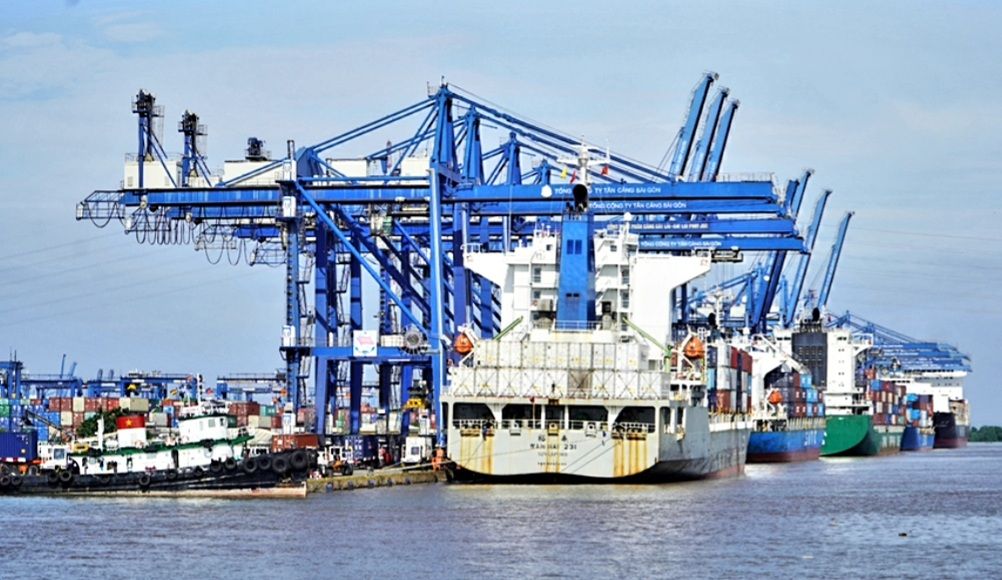In the world, globalization is advancing strongly with market economy development and the Fourth Industrial Revolution. Today, it is not only referred to as the natural law of "universal gravitation" but also the artificial law of "the internet of things" driven by scientific and technological advancements. Emerging technologies, coupled with a world climate emergency and growing trade tensions among the United States, China, Russia and Europe, are holding back advanced economies and disrupting supply chains, resulting in global economic decline when two-thirds of world trade is now taking place in global value chains - international operating systems for production and supply of goods and services. But what happens to these systems when the above risks start to affect supply chains? According to the World Economic Forum (WEF), the absence of effective solutions to global supply chain disruptions can lead to losses of up to 30% across the entire value chain.

photo: Internet
With an open, fast-growing economy, Vietnam has bilateral economic relations with more than 230 countries and territories, as well as multilateral relations within 16 free trade agreements (FTAs) with 60 economies. In 2021, the total merchandise export and import value amounted to US$670 billion, nearly double the gross domestic product (GDP). According to the latest Global Economic Forecast Report released by the Institute of Chartered Accountants of England and Wales (ICAEW) and Oxford Economics published in June 2022, Vietnam is forecast to have high growth prospects in the region, over 6.5% in 2022. Vietnam also lies in the heart of ASEAN - an area that has undergone 55 years of development and is moving toward the ASEAN Economic Community (AEC). Meanwhile, ASEAN is located in an important geopolitical position in the Indo-Pacific supply chain, boosted by the formation of the IPEF Initiative together with the construction of the Kra Canal in Thailand. The Kra Canal would a major project providing a new maritime route that connects the Gulf of Thailand and the Andaman Sea and links the Indian Ocean and the Pacific Ocean. It would enable big cost savings, higher levels of safety and security, and shortened distance and time compared to the voyage through the Straits of Malacca.
Perhaps, standard and product supply chains are most concerned in global trade. For Vietnam, this is a great opportunity to actively build a national economic development strategy amid shifts in the global supply chain. In other words, it is necessary for Vietnam to position itself in the product supply chain of multinational corporations, starting from virgin material production and ending with product delivery to consumers. Vietnam's position in the supply chain must ensure cost optimization and a more efficient production cycle so that multinational corporations can reduce costs and stay competitive because they become more dependent on efficiently organized supply chains, including complex logistics, when they grow and expand (regionally, internationally or even globally). This element of the supply chain is important not only to developing large corporations, but also to improving performance and profitability for small and medium-sized enterprises (SMEs) as well as individual investors.
Driven by digital development, logistics plays an increasingly central role in the supply chain not only because of huge investment costs (logistics on average accounts for about 5% of gross domestic product and 20% of the cost price of goods) but also because of its determination to the quality of international trade as every customer wants their products to be delivered quickly and perfectly regardless of distance. The OECD estimates the potential benefit to ASEAN (including Vietnam) from reduced freight costs among countries in the region, from increased competition and trade, at US$4.5 billion a year. The value will increase to a higher level if this area takes proactive action for this. ASEAN is built on trade relationships - the main engine of the region's phenomenal growth and logistics is the bottom of the pyramid necessary for all that trade.
However, like other countries in the region, Vietnam has a lot of shortcomings in logistics development and improvement strategies, including legal environment and investment capital as well as the capture of shifting trends of global supply chains, especially for high-tech products, energy and consumer markets.
According to the 2018 report by the World Bank (WB), Vietnam ranked 39th out of 160 surveyed countries, first among emerging markets and highest among lower middle-income countries.
To effectively seize opportunities for world trade development and its important geographical position in the region, Vietnam needs to have a strategy to position itself in the global supply chain with three main contents:
First, developing ASEAN economic integration and regarding this as a focus for international negotiations and construction of a national supply chain strategy to ensure Vietnam's important position in the region. Particularly, special attention is paid to the Kra Canal project as it will certainly change the landscape of the ASEAN maritime industry and international transport, especially commercial ships on Indo-Pacific routes. The new canal is beneficial to Vietnam in all aspects (especially southern provinces and cities) in terms of economic factors. The natural strengths of the project's geographical characteristics are the reason for economic strategists to seriously study and propose a maritime business plan to reposition Vietnam's supply chain in the National Master Plan for the 2021 - 2030 period, with a vision to 2050.
Second, actively taking part in integration programs with major markets in the region such as RCEP, ASEAN-India, IPEF and CPTPP to capture and connect market development, technology and transformation trends of product and service supply chains.
Third, it is necessary to place the East Sea at the heart of the synchronous infrastructure development strategy, including transportation infrastructure. One, researching, establishing and developing seaport connectivity and post-port supporting services systems with airways, roads, railways and inland waterways by applying solutions to attract and separate goods flows to effectively operate Hai Phong international port (Lach Huyen), Cai Mep-Thi Vai Port, Van Phong Port (Khanh Hoa), Quy Nhon Port (Binh Dinh), Cai Lan Port (Quang Ninh), Saigon Port, Cua Lo Port (Nghe An) and Dung Quat Port (Quang Ngai). Two, improving the business investment environment to enhance business development, applying digital technology and attracting investment in logistics infrastructure development to ensure all five sources of capital - financial, human, social, environmental and physical - to reasonably participate in relevant national projects in the context of the limited financial resources of the Government. Particularly, special attention is paid to the participation of social resources (capital) because this capital will certainly bring trust and social connection, as the ultimate purpose of all projects is to bring satisfaction to the people in society and sustainable national development.
Dr. Doan Duy Khuong





